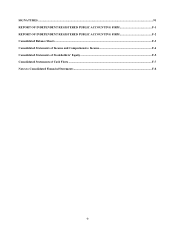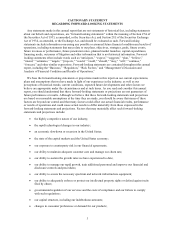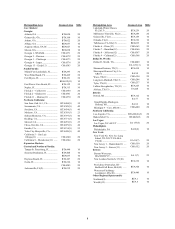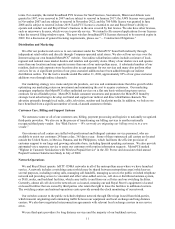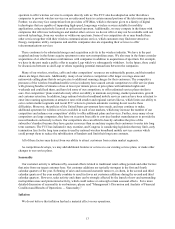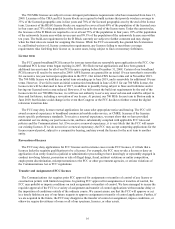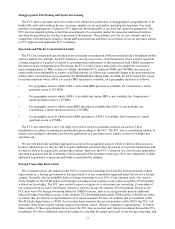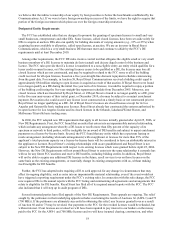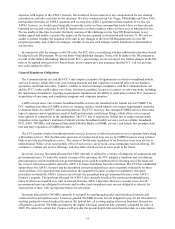Metro PCS 2008 Annual Report Download - page 21
Download and view the complete annual report
Please find page 21 of the 2008 Metro PCS annual report below. You can navigate through the pages in the report by either clicking on the pages listed below, or by using the keyword search tool below to find specific information within the annual report.12
Network Technology
Communications between the subscriber wireless device and our network is accomplished by a frequency
management technology, or “air interface protocol.” The FCC has not mandated a universal air interface protocol for
wireless broadband systems. We and Royal Street have deployed 1xRTT CDMA technology, which is one of the
dominant air interface protocols. Our and Royal Street’s decision to use CDMA is based on what we believe are
several key advantages that CDMA has over other air interface protocols, including higher network capacity, longer
handset battery life, fewer dropped calls, simplified frequency planning, efficient migration path as our CDMA
technology can be easily upgraded to fourth generation air interface protocols in a cost effective manner, and
increased privacy and security. CDMA is incompatible with certain other air interface protocols. Customers and
former customers of other carriers may not be able to use their wireless devices on our or Royal Street’s networks
because either their wireless device uses a different air interface protocol or the other CDMA carriers may have
restricted the customers from changing the programming of their wireless device to allow it to be used on networks
other than the original CDMA carrier’s network.
We also purchase EVRC-B, or 4G vocoder, handsets which will allow for greater capacity in our network and we
are considering other network technology such as long term evolution, or LTE, which we believe would provide
significant increases in network capacity and data rates. This technology may replace or supplement our and Royal
Street’s 1xRTT CDMA network.
Competition
The market for our wireless services is highly competitive. We compete directly in each of our metropolitan
areas with other wireless broadband mobile service providers, wireline, Internet, cable, satellite and other
communications service providers by providing a wireless alternative to traditional wireline service. We believe that
competition for subscribers among wireless broadband mobile providers is based mostly on price, service area,
services and features, call quality and customer service.
The current wireless broadband mobile industry is dominated by four national carriers -- AT&T, Verizon
Wireless, Sprint Nextel and T-Mobile -- and their prepaid affiliates or brands. National carriers typically offer post-
paid plans that subsidize wireless devices, but require long-term service contracts and credit checks or deposits. The
national carriers also have introduced, either directly or through their affiliates, unlimited fixed-rate services plans in
areas in which we offer or plan to offer service. These unlimited fixed-rate service plans may cause other
competitors to introduce similar unlimited fixed-rate plans. In addition, some regional companies, such as Leap,
have unlimited fixed-rate service plans similar to ours and compete, or have announced plans to compete, in certain
of our markets.
Over the past few years, the wireless industry also has seen an emergence of several new competitors that provide
either pay-as-you-go or prepaid wireless services. Some of these competitors, such as Virgin Mobile USA, and
Tracfone, are non-facility based mobile virtual network operators, or MVNOs, that contract with wireless network
operators to provide a separately branded wireless service. These MVNOs typically also charge by the minute rather
than offering flat-rate unlimited service plans.
The wireline industry is dominated by large incumbent carriers, such as AT&T and Verizon, and also includes
competitive local exchange or voice over Internet protocol, or VoIP, service providers. The cable industry also is
dominated by large carriers such as Time Warner Cable, Comcast and Cox Communications. These cable
companies, along with cable company Advance/Newhouse, formed a joint venture called SpectrumCo LLC, or
SpectrumCo, which bid on and acquired 20 MHz of AWS spectrum in a number of major metropolitan areas
throughout the United States, including all of the major metropolitan areas which comprise our Core and Expansion
Markets. Certain large national cable companies, Sprint, Intel, Clearwire and others also have formed a joint
venture to construct a national network to provide wireless data and telecommunications services.
In the future, we may face competition from mobile satellite service, or MSS, providers, and from resellers of
these services. The FCC has granted some MSS providers, and may grant others, the flexibility to deploy an
ancillary terrestrial component to their satellite services. This added flexibility may enhance MSS providers’ ability
to offer more competitive mobile services. In addition, several large satellite companies, computer companies, and
Internet search and portal companies have indicated an interest in establishing next generation wireless networks,
and certain VoIP providers have indicated that in the future they may acquire FCC licenses or use unlicensed


